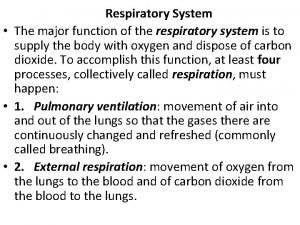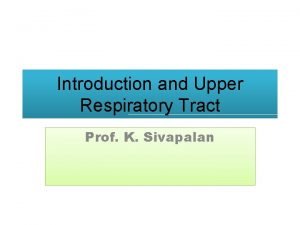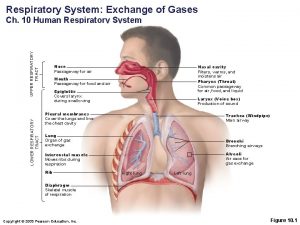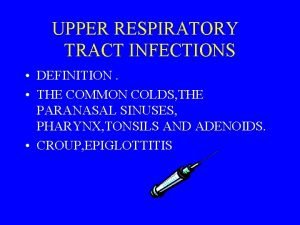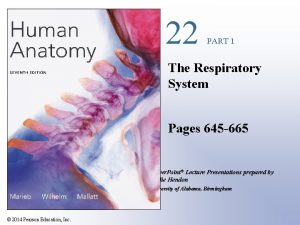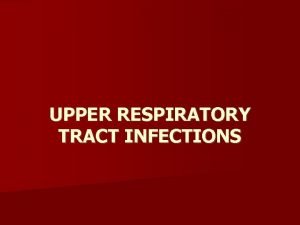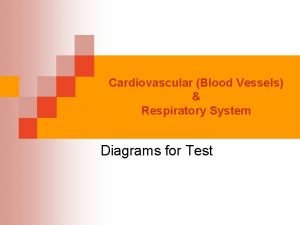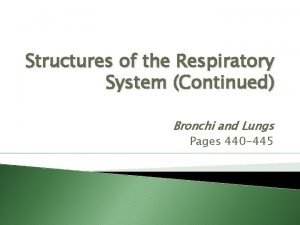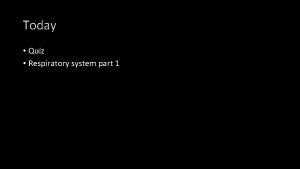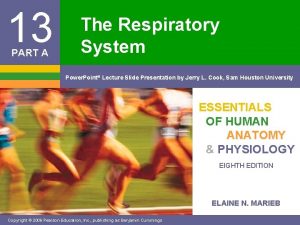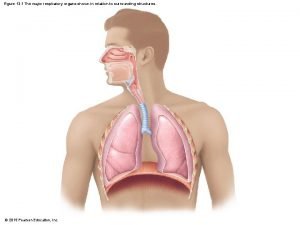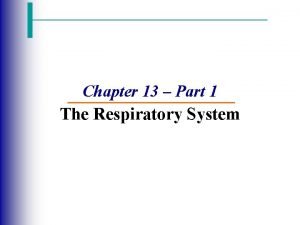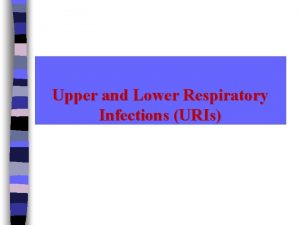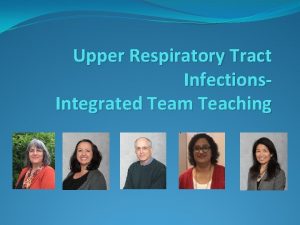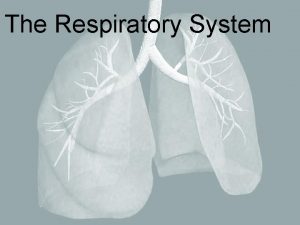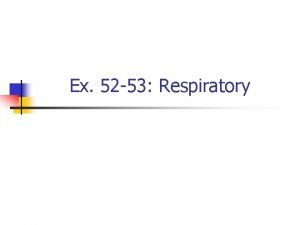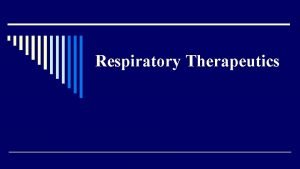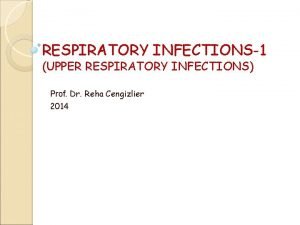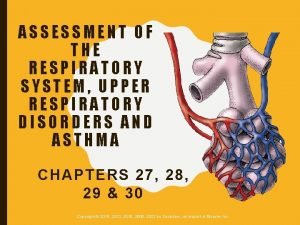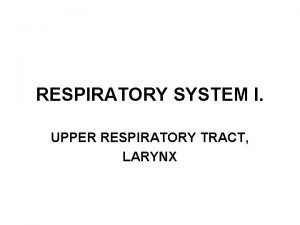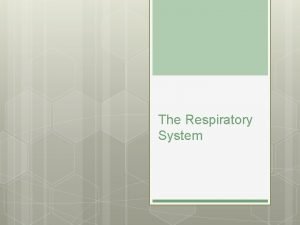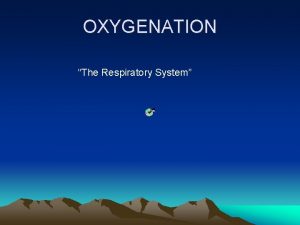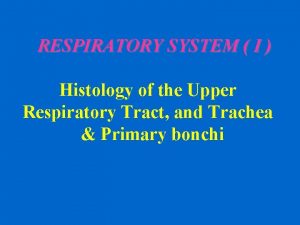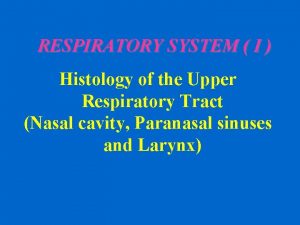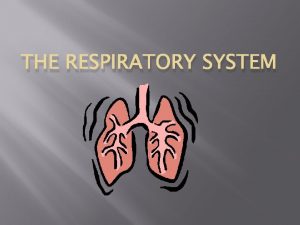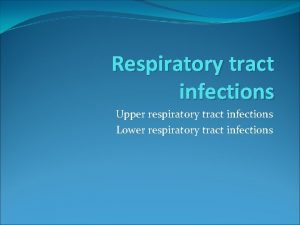Figure 24 1 Structures of the upper respiratory


















































- Slides: 50

Figure 24. 1 Structures of the upper respiratory system. Sinus Nasal cavity Oral cavity Tongue Epiglottis Layrnx (voice box) Trachea (windpipe) Middle ear Auditory (eustachian) tube Opening of auditory tube Tonsils Pharynx (throat) Spine (backbone) Esophagus

Figure 24. 2 Structures of the lower respiratory system. Bronchiole Branch from the pulmonary vein Pharynx (throat) Larynx (voice box) Branch from the pulmonary artery Blood capillaries Left lung Trachea (windpipe) Right lung Alveoli Bronchus Bronchiole Pleura Diaphragm (breathing muscle) Heart

Normal Microbiota of the Respiratory System § Suppress pathogens by competitive inhibition in upper respiratory system § Lower respiratory system is sterile

Upper Respiratory System Diseases § § § Pharyngitis Laryngitis Tonsillitis Sinusitis Epiglottitis: H. influenzae type b

Streptococcal Pharyngitis § § § § Also called strep throat Streptococcus pyogenes Resistant to phagocytosis Streptokinases lyse clots Streptolysins are cytotoxic Diagnosis by enzyme immunoassay (EIA) tests Scarlet fever § Erythrogenic toxin produced by lysogenized S. pyogenes

Figure 24. 3 Streptococcal pharyngitis.

Figure 24. 4 Corynebacterium diphtheriae, the cause of diphtheria. Clubbed cells Palisade arrangement

Figure 24. 5 A diphtheria membrane. Membrane on tonsils

Diphtheria § Corynebacterium diphtheriae: gram-positive rod § Diphtheria toxin produced by lysogenized C. diphtheriae § Prevented by DTa. P vaccine § Diphtheria toxoid § Cutaneous diphtheria § Infected skin wound leads to slow-healing ulcer

Otitis Media § § § S. pneumoniae (35%) H. influenzae (20– 30%) M. catarrhalis (10– 15%) S. pyogenes (8– 10%) S. aureus (1– 2%) Incidence of S. pneumoniae reduced by vaccine

Figure 24. 6 Acute otitis media, with bulging eardrum. Bulging eardrum

The Common Cold § Rhinoviruses (30– 50%) § Coronaviruses (10– 15%)

Diseases in Focus: Microbial Diseases of the Upper Respiratory System Characteristic swollen lymph nodes of this disease.

Lower Respiratory System Diseases § Bacteria, viruses, and fungi cause § Bronchitis § Bronchiolitis § Pneumonia

Pertussis (Whooping Cough) § Bordetella pertussis § Gram-negative coccobacillus § § Capsule Tracheal cytotoxin of cell wall damages ciliated cells Pertussis toxin Prevented by DTa. P vaccine (acellular Pertussis cell fragments)

Figure 24. 7 Ciliated cells of the respiratory system infected with Bordetella pertussis. B. pertussis Cilia © 2013 Pearson Education, Inc.

Pertussis (Whooping Cough) § Stage 1: catarrhal stage, like common cold § Stage 2: paroxysmal stage—violent coughing sieges § Stage 3: convalescence stage

Figure 24. 8 Mycobacterium tuberculosis. Corded growth

Tuberculosis § Mycobacterium tuberculosis § Acid-fast rod; transmitted human-to-human § M. bovis: <1% of U. S. cases; not transmitted from human to human § M. avium-intracellulare complex infects people with late-stage HIV infection

Figure 14. 10 c Epidemiological graphs. Reported cases per 100, 000 people 120 100 80 60 40 20 0 1948 1958 1968 1978 Year Reported tuberculosis cases, 1948– 2010 1988 1998 2008

Figure 24. 11 a Distribution of tuberculosis. 0 – 24 25 – 49 100 – 299 _> 300 50 – 99 Estimated tuberculosis incidence worldwide, per 100, 000 population

Figure 24. 11 b Distribution of tuberculosis. Reported tuberculosis cases per 100, 000 population among American ethnic groups in 2009 Asian and Pacific Islanders Black, non-Hispanic American Indian/ Alaskan native White, non-Hispanic 0 5 10 15 20 25 30 Reported cases per 100, 000 population

Treatment of Tuberculosis § Treatment: prolonged treatment with multiple antibiotics § Vaccines: BCG vaccine, live culture of avirulent M. bovis; not widely used in United States

Figure 24. 10 A positive tuberculin skin test on an arm.

Diagnosis of Tuberculosis § Tuberculin skin test screening § Positive reaction means current or previous infection § Followed by X-ray or CT exam, acid-fast staining of sputum, culturing of bacteria

Figure 24. 12 Streptococcus pneumoniae, the cause of pneumococcal pneumonia. Paired cocci Capsule © 2013 Pearson Education, Inc.

Pneumococcal Pneumonia § Streptococcus pneumoniae: encapsulated diplococci § Symptoms: infected alveoli of lung fill with fluids; interferes with oxygen uptake § Diagnosis: optochin-inhibition test or bile solubility test; serological typing of bacteria § Treatment: macrolides, fluoroquinolones § Prevention: pneumococcal vaccine

Haemophilus influenzae Pneumonia § Gram-negative coccobacillus § Predisposing factors: alcoholism, poor nutrition, cancer, or diabetes § Symptoms: resemble those of pneumococcal pneumonia § Diagnosis: isolation; special media for nutritional requirements § Treatment: cephalosporins

Mycoplasmal Pneumonia § Primary atypical pneumonia; walking pneumonia § Mycoplasma pneumoniae § Pleomorphic, wall-less bacteria § Common in children and young adults

Figure 24. 13 Colonies of Mycoplasma pneumoniae, the cause of mycoplasmal pneumonia.

Figure 11. 18 b Mycloplasma pneumoniae. This micrograph shows the filamentous growth of M. pneumoniae. Some individual cells can also be seen (arrow). The organism reproduces by fragmentation of the filament at the bulges.

Mycoplasmal Pneumonia § Symptoms: mild but persistent respiratory symptoms; low fever, cough, headache § Diagnosis: PCR and serological testing § Treatment: tetracyclines

Legionellosis § Legionella pneumophila § Gram-negative rod § Found in water § Transmitted by inhaling aerosols; not transmitted from human to human

Legionellosis § Symptoms: potentially fatal pneumonia that tends to affect older men who drink or smoke heavily § Diagnosis: culture on selective media, DNA probe § Treatment: erythromycin

Chlamydial Pneumonia § Chlamydophila pneumoniae § Transmitted from human to human § Symptoms: mild respiratory illness common in young people; resembles mycoplasmal pneumonia § Diagnosis: serological tests § Treatment: tetracyclines

Q Fever § § Causative agent: Coxiella burnetii Reservoir: large mammals Tick vector Can be transmitted via unpasteurized milk

Figure 24. 14 Coxiella burnetii, the cause of Q fever. E Masses of Coxiella burnetii growing in a placental cell. This cell has just divided; notice the endospore-like body (E), which is probably responsible for the relative resistance of the organism.

Q Fever § Symptoms: mild respiratory disease lasting 1– 2 weeks; occasional complications such as endocarditis occur § Diagnosis: growth in cell culture § Treatment: doxycycline and chloroquine

Viral Pneumonia § Viral pneumonia occurs as a complication of influenza, measles, or chickenpox § Viral etiology suspected if no other cause is determined

Respiratory Syncytial Virus (RSV) § § Common in infants; 4500 deaths annually Causes cell fusion (syncytium) in cell culture Symptoms: pneumonia in infants Diagnosis: serological test for viruses and antibodies § Treatment: ribavirin, palivizumab

Influenza (Flu) § Symptoms: chills, fever, headache, and muscle aches § No intestinal symptoms § 1% mortality, very young and very old § Treatment: zanamivir and oseltamivir inhibit neuraminidase § Prophylaxis: multivalent vaccine

Figure 24. 15 Detailed structure of the influenza virus. NA spike Capsid layer HA spike Envelope © 2013 Pearson Education, Inc. 2 of 8 RNA segments in genome

The Influenza Virus § Hemagglutinin (HA) spikes used for attachment to host cells § Neuraminidase (NA) spikes used to release virus from cell § Antigenic shift § Changes in HA and NA spikes § Probably due to genetic recombination between different strains infecting the same cell § Antigenic drift § Point mutations in genes encoding HA or NA spikes § May involve only one amino acid § Allows virus to avoid mucosal Ig. A antibodies

Influenza Serotypes Type Antigenic Subtype Year Severity A H 3 N 2 H 1 N 1 H 2 N 2 H 3 N 2 H 1 N 1 1889 1918 1957 1968 1977 Moderate Severe Moderate Low B None 1940 Moderate C None 1947 Very mild

Figure 24. 16 Histoplasma capsulatum, a dimorphic fungus that causes histoplasmosis. Yeastlike H. capsulatum Microconidia Macroconidia Yeastlike form typical of growth in tissue at 37°C. Notice that one yeastlike cell to the left of center is budding. The macroconidia are especially useful for diagnostic purposes. Microconidia bud off from hyphae and are the infectious form. At 37°C in tissues, the organism converts to a yeast phase composed of oval, budding yeasts.

Figure 24. 17 Histoplasmosis distribution.

Coccidioidomycosis § § § Causative agent: Coccidioides immitis Reservoir: desert soils of American Southwest Symptoms: fever, coughing, weight loss Diagnosis: serological tests Treatment: amphotericin B

Figure 24. 19 The U. S. endemic area for coccidioidomycosis. 2001 outbreak San Joaquin Valley Areas where disease is known to be endemic

Pneumocystis Pneumonia § § § Causative agent: Pneumocystis jirovecii Reservoir: unknown; possibly humans or soil Symptoms: pneumonia Diagnosis: microscopy Treatment: trimethoprim

Other Fungi Involved in Respiratory Disease § Systemic § Predisposing factors: § Immunocompromised state § Cancer § Diabetes § Aspergillus fumigatus § Mucor § Rhizopus
 Upper respiratory tract organs
Upper respiratory tract organs What is the conducting zone of the respiratory system
What is the conducting zone of the respiratory system Upper respiratory tract
Upper respiratory tract Anatomy of the upper respiratory tract
Anatomy of the upper respiratory tract Acute upper respiratory infection unspecified คือ
Acute upper respiratory infection unspecified คือ Upper and lower respiratory system
Upper and lower respiratory system Ophthalmootorhinolaryngology
Ophthalmootorhinolaryngology External nose
External nose Upper respiratory tract
Upper respiratory tract Classification of upper respiratory tract infection
Classification of upper respiratory tract infection Respiratory zone structures
Respiratory zone structures Structures of the alveoli and the respiratory membrane
Structures of the alveoli and the respiratory membrane Art-labeling activity: figure 13.2
Art-labeling activity: figure 13.2 Nasal cavity
Nasal cavity Analogous structure
Analogous structure Figure 13-6 is a diagram showing respiratory volumes
Figure 13-6 is a diagram showing respiratory volumes Figure 13-2 respiratory system
Figure 13-2 respiratory system Chapter 13 respiratory system figure 13-4
Chapter 13 respiratory system figure 13-4 Distal tubule
Distal tubule Tia chieu sa te
Tia chieu sa te điện thế nghỉ
điện thế nghỉ Một số thể thơ truyền thống
Một số thể thơ truyền thống Trời xanh đây là của chúng ta thể thơ
Trời xanh đây là của chúng ta thể thơ Thế nào là hệ số cao nhất
Thế nào là hệ số cao nhất Sơ đồ cơ thể người
Sơ đồ cơ thể người Frameset trong html5
Frameset trong html5 Số nguyên là gì
Số nguyên là gì đặc điểm cơ thể của người tối cổ
đặc điểm cơ thể của người tối cổ Các châu lục và đại dương trên thế giới
Các châu lục và đại dương trên thế giới Glasgow thang điểm
Glasgow thang điểm ưu thế lai là gì
ưu thế lai là gì Tư thế ngồi viết
Tư thế ngồi viết Cái miệng xinh xinh thế chỉ nói điều hay thôi
Cái miệng xinh xinh thế chỉ nói điều hay thôi Mật thư anh em như thể tay chân
Mật thư anh em như thể tay chân Các châu lục và đại dương trên thế giới
Các châu lục và đại dương trên thế giới Từ ngữ thể hiện lòng nhân hậu
Từ ngữ thể hiện lòng nhân hậu Bổ thể
Bổ thể Tư thế ngồi viết
Tư thế ngồi viết Thẻ vin
Thẻ vin Thế nào là giọng cùng tên?
Thế nào là giọng cùng tên? Thơ thất ngôn tứ tuyệt đường luật
Thơ thất ngôn tứ tuyệt đường luật Bài hát chúa yêu trần thế alleluia
Bài hát chúa yêu trần thế alleluia Khi nào hổ con có thể sống độc lập
Khi nào hổ con có thể sống độc lập Diễn thế sinh thái là
Diễn thế sinh thái là Vẽ hình chiếu vuông góc của vật thể sau
Vẽ hình chiếu vuông góc của vật thể sau Công thức tiính động năng
Công thức tiính động năng Làm thế nào để 102-1=99
Làm thế nào để 102-1=99 Tỉ lệ cơ thể trẻ em
Tỉ lệ cơ thể trẻ em Lời thề hippocrates
Lời thề hippocrates Vẽ hình chiếu đứng bằng cạnh của vật thể
Vẽ hình chiếu đứng bằng cạnh của vật thể đại từ thay thế
đại từ thay thế


